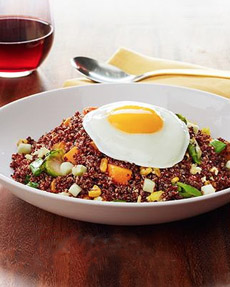RECIPE: Quinoa Grain Bowl For Breakfast, Brunch & Lunch
|
|
The quinoa bowl recipe is below, but first: There’s a yummy recipe for a quinoa breakfast bowl below. But first, a word about breakfast. Traditional American breakfasts are echoes of the elaborate breakfasts of the English gentry, which fortified them for a day of sport. They’re much less elaborate today, but regular Brits can still enjoy a heaping plate of eggs, bacon, black and white sausage, beans, kidneys, kippers, mushrooms, potatoes, and tomatoes, with a side of fried bread. In the late 19th century, the morning fare for wealthy Americans was similar: eggs with cutlets, ham, fried fish, deviled kidneys, black pudding (sausage), cold grouse or pheasant, fruit, and pie. The less affluent made do with eggs or porridge. No wonder thousands of the well-to-do headed to spa-like sanitariums for rejuvenation. At one sanitarium, a physician named Caleb Jackson changed the way his clients breakfasted. In 1863, he developed a healthful, spartan, fiber-filled breakfast—the first cold breakfast cereal. Granula, as he called it, was an early version of Grape-Nuts, whose inventor, C.W. Post, first had it when a patient at another sanitarium. To make granula, baked sheets of graham flour dough were dried, broken into nuggets, baked again, and broken into smaller pieces. The resulting dense, chewy grain clusters had to be soaked overnight in milk before serving. Other spas followed suit; and as prepared, packaged foods became more common, granula paved the way for Bran Flakes (1915), All Bran (1916), Rice Krispies (1927) and Raisin Bran* (1942), eaten with milk and sugar. In 1951 the onslaught of heavily sugared cereals targeted to kids began, producing Corn Pops, Frosted Flakes, Honey Smacks and Cocoa Krispies. Here’s a detailed history of breakfast cereal. Around the world, there’s less of a distinction in foods served for breakfast versus other meals. |
|
|
A DIFFERENT APPROACH TO BREAKFAST Today’s tip is for a hybrid breakfast, combining breakfast eggs with dinner items: cooked grains and vegetables. The recipe below was devised by Good Eggs in San Franciso, as a light dinner entrée: a poached egg with quinoa and broccoli rabe. They call it a grain bowl. But we make it for breakfast, to replace butter-fried or -scrambled eggs and hash browns (or bagels and cream cheese) with better-for-you chow. You can also serve it for brunch or lunch, You can replace the poached egg with another style, the quinoa with other grains or legumes, and the broccoli rabe with your vegetable of choice. Prep time is 15 minutes, total time is 20 minutes. > Check out the difference between broccoli, broccoli rabe and broccolini, below. Ingredients For 2 Servings _______________________________________ *We substituted chopped pistachio nuts, untoasted. You can substitute other nuts or seeds. †If you plan to garnish with flake salt, under-salt the rabe and quinoa. ‡We didn’t have time to clarify, so used melted butter. |
||
|
Preparation 1. TOAST the pine nuts: Heat a pan over medium heat and add the pine nuts. Toast for 3-5 minutes, tossing them in the pan occasionally to ensure an even color. Remove when they’re golden brown and transfer to a bowl. 2. RETURN the pan to the stove, add 2 tablespoons of olive oil and turn the heat to high. When the oil is hot, add the garlic and sauté for about 3 minutes. As soon as the garlic starts to turn golden brown, turn the heat down to medium and add the broccoli rabe and a pinch or two of chile flakes. 3. TOSS the rabe in the oil and garlic using tongs, and sauté together for 5-7 minutes. Add a pinch or two of salt and taste. You want the leaves to be tender and the flavor to be a bit bitter, but delicious. If the rabe still has too much kick for your taste, cook for a few minutes longer. When the rabe is done, remove from heat and set aside. While the broccoli cooks… 4. SEASON the quinoa. Add the ghee and herbs to the quinoa and stir thoroughly. Finish with a few pinches of salt and a few grinds of pepper to taste. 5. COOK the eggs. You may have your own way of poaching eggs (we use an egg poacher; the result is less pretty but it’s a lot easier). Otherwise, here’s a technique from Good Eggs. |
|
|
|
|
||




